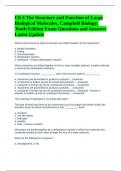Exam (elaborations)
Ch 5 The Structure and Function of Large Biological Molecules, Campbell Biology; Tenth Edition Exam Questions and Answers Latest Update
- Course
- Institution
Ch 5 The Structure and Function of Large Biological Molecules, Campbell Biology; Tenth Edition Exam Questions and Answers Latest Update
[Show more]



